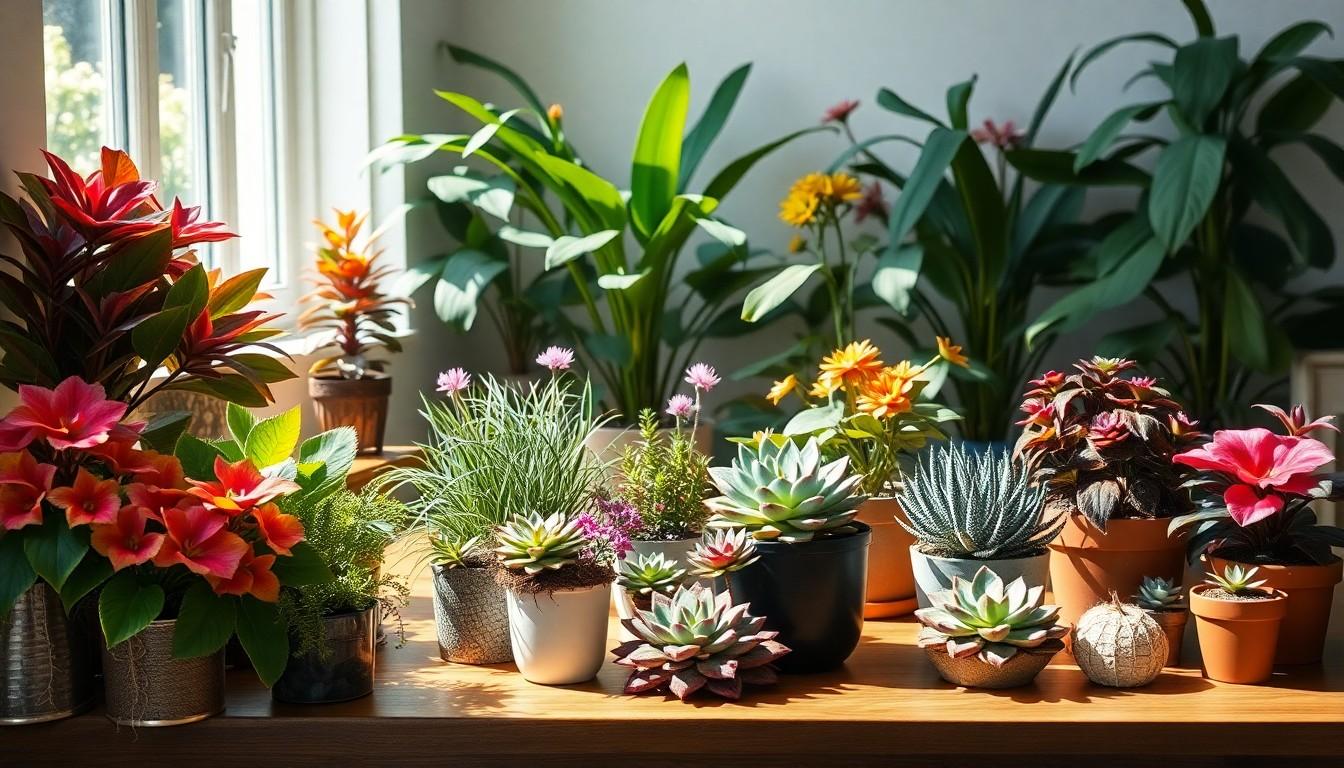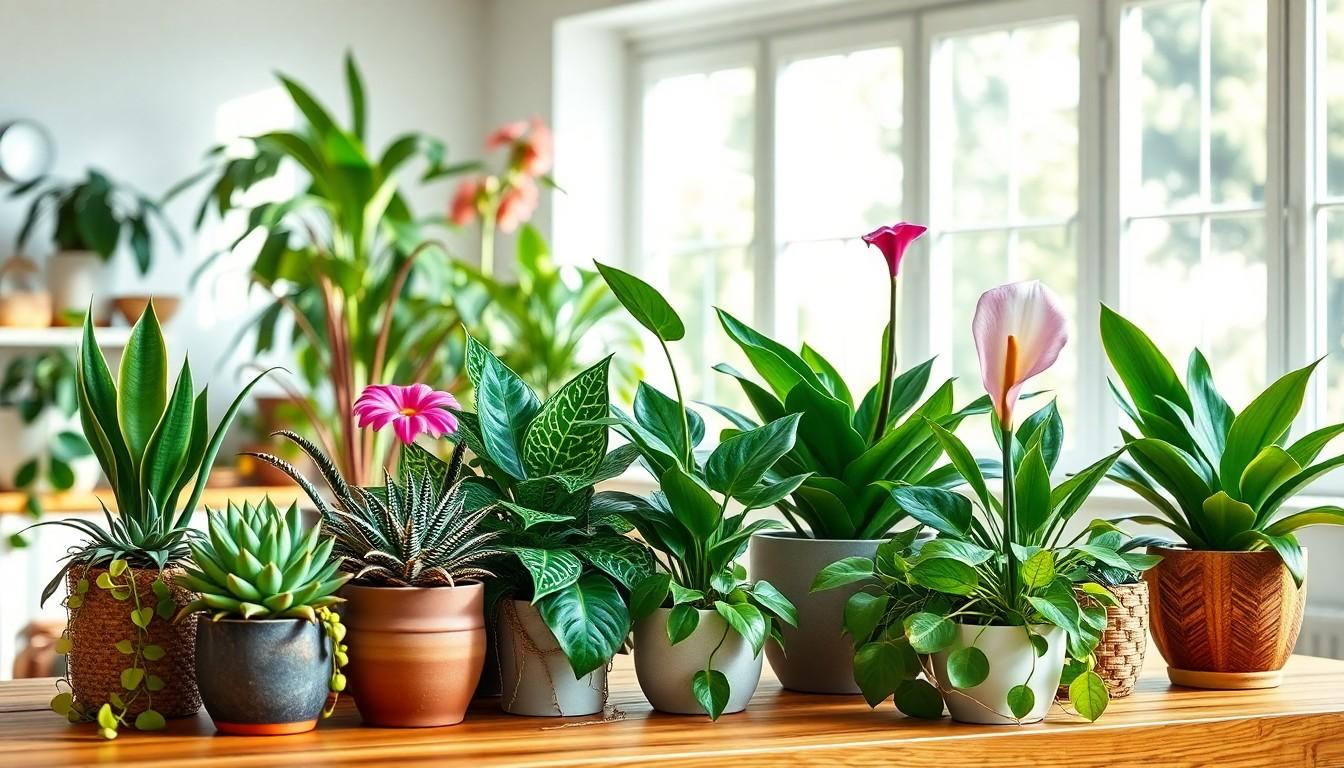House plants are like the quirky roommates everyone needs—low maintenance, great company, and they never steal the remote. With a splash of green, they can transform any dull corner into a vibrant oasis. Whether you’re a seasoned plant parent or just dipping your toes into the leafy waters, there’s a perfect plant waiting to join your home.
Overview of House Plants
House plants encompass a variety of categories, each offering distinct characteristics and care requirements. Popular types include succulents, which thrive in dry conditions and require minimal watering. Tropical plants, such as philodendrons and monstera, prefer humidity and indirect light. Ferns showcase lush foliage and do well in shaded areas.
Common indoor plants like spider plants and pothos adapt easily to diverse environments. They tolerate low light levels and irregular watering schedules, making them excellent choices for beginners. Cacti stand out for their vibrant blooms and drought resistance, bringing a unique visual appeal.
Aesthetic aspects play a significant role in plant selection. Colorful flowers from species like African violets add vibrancy, while foliage plants like snake plants offer structure. Aromatic herbs, such as basil or mint, provide culinary benefits along with greenery.
Sustainability needs shape plant choices too. Native plants often require less maintenance and adapt seamlessly to home environments. Eco-friendly options include air plants, which absorb moisture from the air and demand minimal care.
Selecting house plants includes considering individual preferences. Some individuals enjoy plants that promote wellness, like peace lilies, known for air-purifying properties. Others may choose ornamental plants purely for beauty.
Regardless of type, house plants enhance indoor spaces significantly. They improve air quality, boost mood, and create a calming atmosphere. With various options available, individuals can find plants that complement their lifestyle and aesthetic goals, ensuring a boost in their living area.
Common Types of House Plants

House plants come in various types, each offering unique features and care requirements. Understanding these categories helps in selecting the right plants for specific home environments.
Foliage Plants
Foliage plants primarily focus on their leaves, showcasing vibrant greens and varied textures. Popular examples include the snake plant and rubber plant. These plants usually tolerate low light and irregular watering, making them ideal for busy individuals. Many foliage plants purify indoor air and adapt well to different conditions.
Flowering Plants
Flowering plants bring color and vibrancy indoors with their stunning blooms. African violets and peace lilies are well-known examples. These plants often require more light and consistent care to thrive, but they reward growers with beautiful flowers. Regular watering and appropriate fertilization can enhance blooming periods.
Succulents and Cacti
Succulents and cacti are low-maintenance options that store water in their leaves. Varieties like aloe vera and jade plants are popular choices for beginners. They thrive in bright sunlight and require minimal watering, making them perfect for those with busy lifestyles. Their unique shapes and textures add character to any space.
Benefits of House Plants
House plants offer numerous advantages that enhance indoor living spaces. These plants contribute positively to physical and mental well-being.
Improved Air Quality
House plants significantly improve air quality. They absorb harmful toxins such as formaldehyde and benzene. NASA’s Clean Air Study identified several species for their effectiveness, including snake plants and spider plants. Increased humidity levels also result from plants transpiring, which benefits respiratory health. Clean, fresh air helps reduce fatigue and promotes overall wellness. A greener environment decreases stress and boosts concentration levels, making it easier to focus on tasks. Healthier air quality ultimately enhances comfort in living spaces.
Aesthetic Appeal
House plants enhance the aesthetic appeal of any room. Vibrant foliage adds color and liveliness to dull areas. Various plants like peace lilies produce attractive blooms, generating visual interest. Unique textures from succulents and ferns create captivating displays. Arranging plants in creative ways can transform a space into a soothing oasis. Natural elements bring warmth and charm to interiors, making them inviting. Decorative pots and creative plant arrangements further complement the overall decor theme. A well-placed house plant often serves as a conversation starter.
Tips for House Plant Care
Caring for house plants enhances their growth and longevity. Specific attention to watering and light levels yields the best results.
Watering Guidelines
Watering techniques vary by plant type. Succulents thrive on infrequent watering, ideally every two to three weeks. Tropical plants often need moisture but prefer the top inch of soil to dry out between sessions. Heavily monitor plants like ferns, as they require consistent moisture yet can suffer from overwatering. Checking the pot’s drainage is essential to prevent water logging. Using room temperature water helps plants absorb moisture effectively. Gentle watering methods, such as a watering can or bottom watering, encourage healthy root development. Adjust the frequency during the growing season, as many plants crave more moisture in spring and summer.
Light Requirements
Light needs differ among house plants. Foliage plants like snake plants tolerate low light, thriving in indirect sunlight. Flowering plants generally require brighter locations; peace lilies, for instance, favor medium to bright light conditions. Succulents, on the other hand, seek direct sunlight, typically needing six hours of bright exposure daily. Placing plants near windows helps fulfill their light requirements. Using sheer curtains can also diffuse harsh sunlight for sensitive varieties. Pay attention to signs of inadequate light, such as leggy growth or faded leaves. Moving plants closer to light sources or rotating them regularly promotes balanced growth and health.
Conclusion
House plants offer a unique blend of beauty and functionality that can transform any living space. With a variety of options available, there’s a perfect plant for everyone, whether they’re a seasoned gardener or just starting out.
By selecting the right type of house plant, individuals can enhance their environment while enjoying the numerous health benefits these green companions provide. From improving air quality to boosting mood, house plants create a soothing atmosphere that enriches daily life.
Embracing house plants can lead to a more vibrant and inviting home, making it easy to cultivate a personal oasis that reflects individual style and care preferences.





